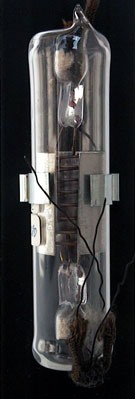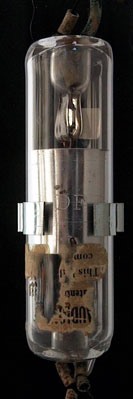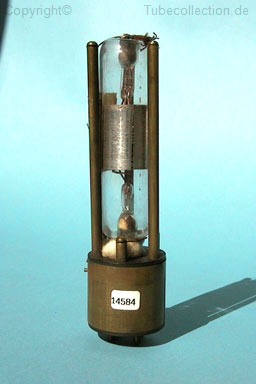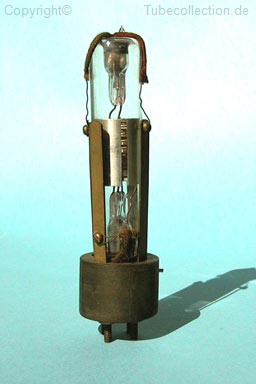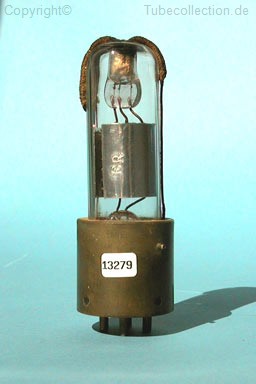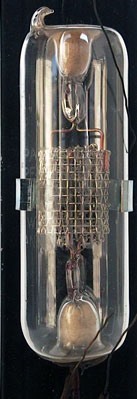|
Auf dieser Seite werden alle Röhren gezeigt, die eine ungesockelte, rohrförmige Konstruktion aufweisen . Sie stammen von unterschiedlichen Herstellern und haben häufig keine klare Typenbezeichnungen. Folgende Begriffe sind für diese Röhrenart bekannt: Audiotron (Cunningham) Der Name AudioTron wurde zuerst ab 1915 von
Elmer T. Cunningham eingeführt und war ab 1916 als dessen Handelsmarke
geschützt. Er wurde bis 1922 verwendet. Die Röhren haben Durchmesser von 16...22 mm und
eine Glaskörperlänge von 75...90 mm. Die Anode steht aus einem
geschlitzten Aluminiumring, der an der Innenseite des Glaskolbens anliegt.
Er ist so in seiner Lage gesichert und kann die Wärme gut abführen. Der
V-förmig gespannte Faden hat 3 Anschlüsse. das Gitter aus Kupferdraht
ist spiralförmig gewickelt. Einige Audiotrons hatten schwarze, einige rote
Typenzettel aufgeklebt. Bei anderen wiederum ist die Beschriftung
eingeätzt. Es begann ein Patentstreit zwischen DeForest und
der Audiotron - Verkaufsgesellschaft, der jedoch später beigelegt wurde.
Um seine Kompetenz zu beweisen brachte DeForest 1916 ein eigenes Tubular
Audion mit einem Faden, die Type T, heraus. Es hat auf dem Anodenzylinder
die Zeichen "D.F."
Während des ersten Weltkrieges durften
Funkamateure ihre Apparate nicht mehr benutzen und so brach der Markt für
Audiotrons ein. Erst wieder ab 1919 erschienen weitere Anzeigen in
Fachzeitschriften. In 1919 wurde von RCA ein Prozess gegen
Cunningham geführt, der in Lieferverträgen endete. Ab 1920 wurden nach
der Spezifikation von Cunningham Audiotrons von RCA geliefert, jedoch unter
Cunningham vertrieben. Das Electronic Relay wurde von Moorhead
hergestellt. Es hatte einen geschlossenen Anodenzylinder und ein Gitter
mit einer groben Gewinde-Steigung, aber nur einem Faden.
Nachfolgend Beispiele von "Tubular Audions" aus meiner Sammlung. |
On this page are only shown tubes of tubular construction and instead of bases only having wires. They are from different manufacturers and some of them don`t have any identification. The following expressions were used for this kind of tubes: Audiotron (Cunningham)
The first name "Audiotron" was used by Cunningham in 1915 and was registered as brand name in 1916. It was used until 1922. The tubes had a diameter of 16..22mm and a lenght of 75..90mm. The anode consists of an open ring of aluminium, outer diameter corresponding to the inner diameter of the glas bulb. By this ist i fixed in a safe position and can conduct the heat to the glas cylinder. The V-shaped filament has 3 terminals and the grid is spiral shaped, made of copper wire. Some "Audiotrons" had black, some are red paper lables around the bulb. Others had an edged lettering. After the Audiotron appeared, DeForest filed suit against the Audiotron Sales Company. To demonstrate his competition he made in 1916 a type T tubular audion with one filament . On the anode cylinder was punshed the marking "DF" for DeForest. Dureing WWI the radio amateurs where not allowed to use their equipment and by this the marked for audiotrons broke down. First in 1919 appeared further advertising in professional journals In 1919 RCA filed suit against Cunningham, infringing the Fleming and de Forest patents. This ended in an agrement and contract. From 1020 Audiotron where supplied to Cunninghams specifications. The "electronic relay" was produced by Moeerhead. The tube had a closed anode cylinder and a grid with a broad pitch and only one filament. Following some "Tubular Audions" from my collection.
|





